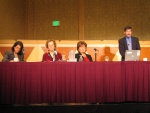|
NSF Program Manager Panel
|
This morning's keynote panel was on "New Directions in Digital Government Research." The panelists were Dr. Michael Pazzani, Division Director, IIS, NSF, Dr. Suzanne Iacono, Dr. Sylvia Spengler, and Dr. Miriam Heller.
Dr. Pazzani spoke on the NSF structure and how PIs should work with NSF. There is a web site that gives statistics and other information about grants that have been given. Over the last five years the number of proposals to the IIS Division has increased from 2000 per year to over 5000. Not good news for anyone hoping for NSF money. They competition is fierce.
NSF looks at two criteria: "What is the intellectual merit and quality of the proposed activity" and "What are the broader impacts of the proposed research?" This latter criterion has been subject to some questions from PIs. He adds some clarifying questions: "To what extent does this advance societal goals?" "How will the research impact society?"
Well-written proposals that address broader impacts that are both innovative and achievable are most likely to get funded.
Suzi Iacnon is the program manager for ITR. ITR is charged with research into issues in information technology. The idea is to fund large, long projects. ITR is in the last year of a five year program as an NSF priority area. This year's focus is "IT Research fo National Priorities." The focus is on tools, techniques, systems, methods, theories, and models for large-scale integrated, distributed systems. Interdisciplinary proposals are encouraged. ITR is aiming for a 10% success rate this year (past years have been over 20%) with an average of $1.25 Million over four years. There is a direct correlation between the amount of time you spend understanding and learning about NSF and success in getting grants. Visit NSF and talk to the program director.
Sylvia Spengler is program manager for Information Integration and Informatics. III is a new program. There are two parts. The first is the Science and Engineering Informatics (SEI). Proposals in this area require both a significant problem in science as well as a significant problem in computer science that can both be addressed by the research. Collaboration encouraged. The second part is Information Integration. This includes reconciling heterogeneous data formats, web semantics, decentralized data sharing, on-the-fly integration, and so on.
Miriam Heller is program manager for Human and Social Dynamics. HSD is a cross-disciplinary program in its first year. The goal is to "stimulate breakthroughs in social science that expand the frontiers of our understanding of complex human systems at multiple scales of temporal, spatial, and organizational dimension focusing on the dynamics of cause, behavior, and decision-making by exploiting and enriching multiple disciplines." Past the buzz-words, she mentions agents and emergent behavior as examples of the kinds of things they're interested in. This year's topical emphasis areas are agents of change, dynamics of human behavior, and decision making and risk. Proposals much include at least one of the areas.
SEGR (small grants for exploratory research) are encouraged for innovative, "wild and wooly" ideas. These projects are generally higher risk than standard projects.





